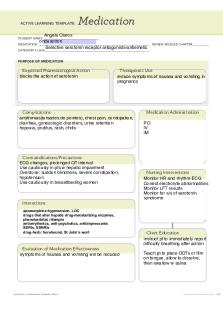Nagpra - Course Assignments PDF

| Title | Nagpra - Course Assignments |
|---|---|
| Author | Wayne Besty |
| Course | BUSINESS MANAGEMENT |
| Institution | Gannon University |
| Pages | 2 |
| File Size | 35.6 KB |
| File Type | |
| Total Downloads | 62 |
| Total Views | 135 |
Summary
Course Assignments...
Description
NATIVE AMERICAN GRAVES PROTECTION AND REPATRIATION ACT Public Law 101-601 was ratified by the Senate and House of Representatives of the United States of America on November 16, 1990. This law came to be identified as NAGPRA, the short form for the Native American Graves Protection and Repatriation Act. NAGPRA proclaims the rights of Indian tribes, lineal posterities, Native Hawaiian society, and Alaska Native Villages to the return of cultural patrimony. The Law places the obligation for acquiescence on federal agencies, associations, and museums that received federal finance as well as guaranteeing that all agencies and subdivisions of the United States complete catalogs of human remains and related memorial offerings and précises of the Native American material relics that may be unassociated commemorative contributions, sacred objects or objects of cultural patrimony in their assortments. NAGPRA mainly says that American Indian indigenous societies have a right to know where their descendants and their possessions are put in storage and NAGPRA guarantees that they will be returned home. The return of individuals and items to the people and places from which they originated from, did not begin with NAGPRA, but the act augmented claims for the return of human relics, allied and unassociated funereal items, sacred entities, and objects of ethnic patrimony from assemblages in federally financed arts centers. NAGPRA lays out guiding principles for repatriation, as well as dates by which records of collections had to be finalized and mailed out to tribal nation-states. These records notified perhaps culturally associated groups what was obtainable to be appealed. This notice is envisioned to be part of a good faith effort to start the consultation procedure, during which tribal agents travel to arts centers to inspect collections
and confer matters of repatriation. NAGPRA’s session necessities meant that, after numerous decades of collecting, arts centers were obligated to reach out to communities for the first time. It is vital to distinguish what changes in display enterprise owing to NAGPRA look-like. Most noticeable of course is the exclusion of items to be repatriated. This is also the solitary sort of modification that it is likely to demonstrate is completely due to NAGPRA. Others, such as abstraction of items due to matters of cultural thoughtfulness, are I argue a consequence of changing relations which have been affected by NAGPRA’s necessities for discussion, as well as modifications in museology more generally. Other variations of this type are addition of more Native American intellectuals and community members in the enterprise procedure, and snowballing focus on current Native people and the subjects they deem applicable. The impact of NAGPRA on the relations between Native American tribes and institutions cannot be overelaborated. While there was Native involvement in museums prior to NAGPRA, the Act manifested the conception of a watershed in relations between Native Americans as well as Native Alaskans and institution of higher education, museums and federal organizations. The Act has not just affected arts centers and archaeologists, but has developed a pathway headfirst for anthropologists who work with Native North American folks by revamping the conducts in which these two sets have traditionally correlated to one another....
Similar Free PDFs

Nagpra - Course Assignments
- 2 Pages

Assignments
- 31 Pages

Ondasetron - assignments
- 1 Pages

Fluconazole - assignments
- 1 Pages

Equitable Assignments
- 10 Pages

Wrriten Assignments
- 1 Pages

Assignments A
- 14 Pages

Intro assignments
- 1 Pages

Homework - assignments
- 5 Pages

Seminar assignments
- 11 Pages

Econ201 assignments
- 2 Pages

Seminar assignments
- 3 Pages

Lansoprazole - assignments
- 1 Pages
Popular Institutions
- Tinajero National High School - Annex
- Politeknik Caltex Riau
- Yokohama City University
- SGT University
- University of Al-Qadisiyah
- Divine Word College of Vigan
- Techniek College Rotterdam
- Universidade de Santiago
- Universiti Teknologi MARA Cawangan Johor Kampus Pasir Gudang
- Poltekkes Kemenkes Yogyakarta
- Baguio City National High School
- Colegio san marcos
- preparatoria uno
- Centro de Bachillerato Tecnológico Industrial y de Servicios No. 107
- Dalian Maritime University
- Quang Trung Secondary School
- Colegio Tecnológico en Informática
- Corporación Regional de Educación Superior
- Grupo CEDVA
- Dar Al Uloom University
- Centro de Estudios Preuniversitarios de la Universidad Nacional de Ingeniería
- 上智大学
- Aakash International School, Nuna Majara
- San Felipe Neri Catholic School
- Kang Chiao International School - New Taipei City
- Misamis Occidental National High School
- Institución Educativa Escuela Normal Juan Ladrilleros
- Kolehiyo ng Pantukan
- Batanes State College
- Instituto Continental
- Sekolah Menengah Kejuruan Kesehatan Kaltara (Tarakan)
- Colegio de La Inmaculada Concepcion - Cebu


